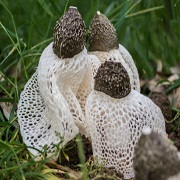XIANG Gang, MA Yuanhao, LIU Ping, LI Zimi, CHAI Hongmei, ZHAO Yongchang
A novel morel cultivation mode using spawn bottles was developed. In the new mode, mycelial blocks were inoculated into transparent glass jars (560 mL each) filled with cultivation substrate (spawn bottle), cultivated at 18 ℃ in darkness for 3 d to allow mycelial growth, and then the spawn bottles were placed on planting land with the mouth down on the ground and cultivated until harvest. Different cultivation substrates in combination with different spawn bottle numbers per cultivation plot of 1.5 m×1.5 m were studied on three strains of Morchella sextelata, YAASJNLM1-31, YAASJNLM6-6 and YAASJNLM6-20, respectively. Different cultivation substrates comprised different proportions of wheat grain and sawdust, including 100% sawdust (M0), 25% wheat grain+75% sawdust (M1), 50% wheat grain+50% sawdust (M2), 75% wheat grain+75% sawdust (M3) and 100% wheat grain (M4), respectively. Different spawn bottle placements were 8, 12, 14 and 16 bottles per cultivation plot of 1.5 m×1.5 m, respectively. Each strain was cultivated in all 20 combinations of the above conditions, and then measured for yield and nutrient consumption in spawn bottles. The results showed that the yield of YAASJNLM1-31 was high using M1 and 16 bottles per cultivation plot. When cultivated on M4, the yield of YAASJNLM1-31 was high under 12, 14 and 16 bottles per cultivation plot. When 14 or 16 bottles were placed on a cultivation plot, the yield of YAASJNLM1-31 was high on M1-M4. For YAASJNLM6-6, high yields were obtained under the following combinations: M2×8 bottles per cultivation plot, M3×8 bottles per cultivation plot, M4×8 bottles per cultivation plot, M1×12 bottles per cultivation plot, M2×12 bottles per cultivation plot, M3×12 bottles per cultivation plot, M4×12 bottles per cultivation plot, M2×14 bottles per cultivation plot, and M3×14 bottles per cultivation plot. For YAASJNLM6-20, high yields were obtained under M1-M4 with 8 bottles per cultivation plot. For YAASJNLM1-31, the substrate consumption ratio of each treatment group varied greatly (40.81%-64.75%). The consumption ratio of YAASJNLM1-31 on M0 was 40.81%-41.73%, and the consumption ratio of YAASJNLM1-31 on M4 was 49.65%-50.44%. Both organic carbon consumption and total nitrogen consumption were positively correlated with yield. The above results provided a reference to improve morel cultivation mode.
